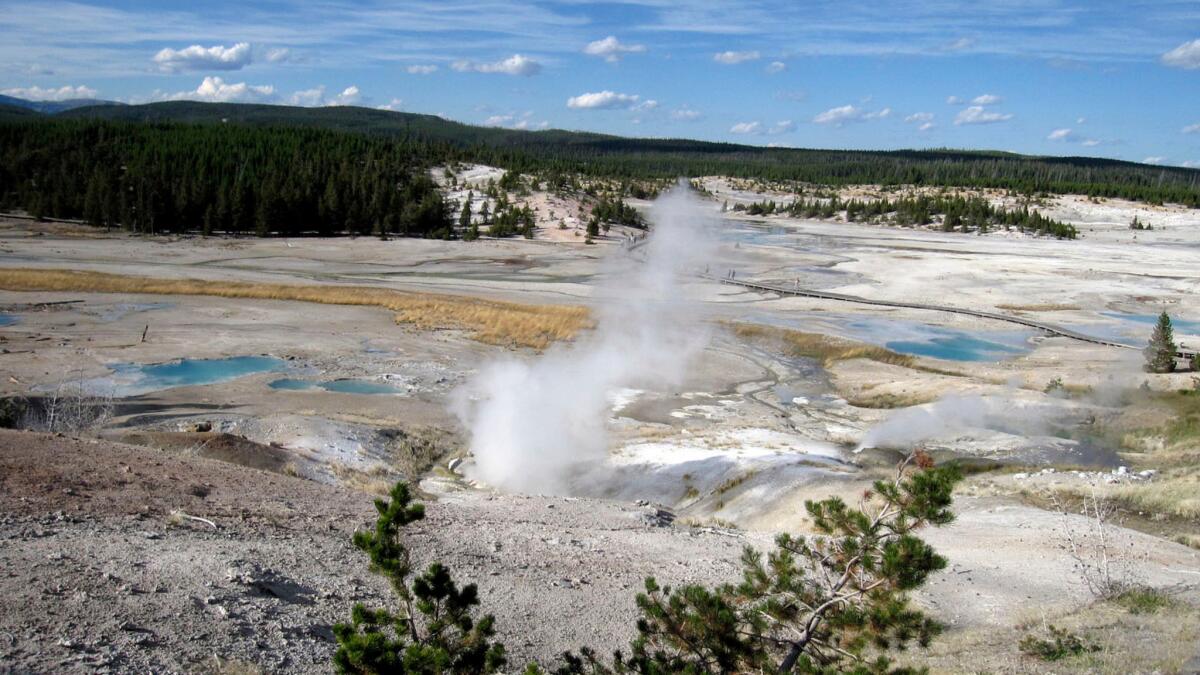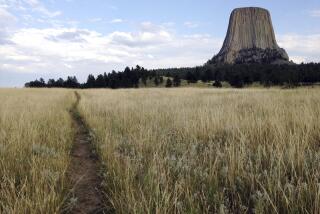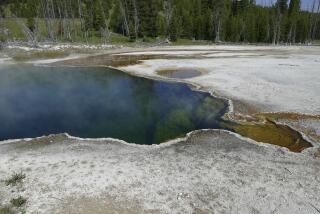Gruesome hot spring death highlights problem of tourists breaking the rules at Yellowstone

- Share via
Reporting from BILLINGS, Mont. — The grisly death of a tourist who left a boardwalk and fell into a high-temperature, acidic spring in Yellowstone National Park offers a sobering reminder that visitors need to follow park rules, park officials and observers said.
Efforts to recover the body of Colin Nathaniel Scott, 23, of Portland, Ore., were suspended on Wednesday after rangers determined there were no remains left in the hot spring.
Scott’s death follows a string of incidents raising questions about tourist behavior at the nation’s first national park as visitor numbers surge. That includes people getting too close to wildlife and entering dangerous areas in violation of regulations.
Yellowstone Supt. Dan Wenk said visitors must keep to designated boardwalks when moving among the park’s hot springs and geysers that blast steaming water high into the air.
Scott and his sister had traveled about 225 yards off the boardwalk on Tuesday when he slipped and fell into the hot spring in the Norris Geyser Basin. Officials said the two had left the boardwalk to get closer to some of the basin’s thermal features.
“This tragic event must remind all of us to follow the regulations and stay on boardwalks,” Wenk said.
After Scott’s sister reported the fall, rangers navigated over the highly fragile crust of the geyser basin to try to recover his body. They halted the effort “due to the extreme nature and futility of it all,” said park spokeswoman Charissa Reid, referring to the high temperature and acidic nature of the spring.
This tragic event must remind all of us to follow the regulations and stay on boardwalks.
— Yellowstone Supt. Dan Wenk
The death occurred in one of the hottest and most volatile areas of Yellowstone, where boiling water flows just beneath a thin rock crust.
It follows high-profile incidents at the rugged park in which tourists got too close to wildlife or went off designated pathways onto unique landmarks, sometimes leading to injuries.
“It’s sort of dumb, if I could be so blunt, to walk off the boardwalks not knowing what you’re doing,” said Kenneth Sims, a University of Wyoming geology professor and member of the Yellowstone Volcano Observatory.
“They’re scofflaws, essentially, who look around and then head off the boardwalk,” he added. Sims said he was speaking generally and had no direct knowledge of the circumstances of Scott’s death.
Scott previously worked as a volunteer at the Jackson Bottom Wetlands Preserve in Oregon, said Mary Loftin, a manager at the Hillsboro, Ore., Parks and Recreation Department. Scott worked there for about 20 months fielding questions from visitors, and his stint ended last year, she said.
“A very nice young man; a bright spirit,” Loftin said.
The basin is a popular attraction in the nation’s first national park, which received a record 4.1 million visitors last year. Water temperatures there can reach 199 degrees, the boiling point for water at the park’s high elevation.
At least 22 people are known to have died from hot spring-related injuries in and around Yellowstone since 1890, park officials said.
Most of the deaths have been accidents, although at least two people had been trying to swim in a hot spring, said park historian Lee Whittlesey, author of the book “Death in Yellowstone.”
The crust that makes up the ground in parts of Yellowstone is formed when minerals underground are dissolved by the high-temperature water, then redeposited on or near the surface.
That crust can be as “thin as a skiff of ice” Reid said.
Other recent tourist incidents at Yellowstone include a 13-year-old boy who was scalded Saturday when his father, who had been carrying him, slipped into a different hot spring.
ALSO
Obama: ‘I am worried about the Republican Party’
China will not build L.A.-to-Vegas rail line — U.S. company calls the deal off
Former Stanford swimmer blames ‘party culture and risk-taking behavior’ for sex assault
UPDATES:
6:06 a.m.: This article has been updated throughout with additional details and background.
This article was originally published at 2:02 a.m.
More to Read
Sign up for Essential California
The most important California stories and recommendations in your inbox every morning.
You may occasionally receive promotional content from the Los Angeles Times.










